|
Family: Bucerotidae (hornbills)
Life
> Eukaryotes >
Opisthokonta
> Metazoa (animals) >
Bilateria >
Deuterostomia > Chordata >
Craniata > Vertebrata (vertebrates) > Gnathostomata (jawed
vertebrates) > Teleostomi (teleost fish) > Osteichthyes (bony fish) > Class:
Sarcopterygii (lobe-finned
fish) > Stegocephalia (terrestrial
vertebrates) > Tetrapoda
(four-legged vertebrates) > Reptiliomorpha > Amniota >
Reptilia (reptiles) >
Romeriida > Diapsida > Archosauromorpha > Archosauria >
Dinosauria
(dinosaurs) > Saurischia > Theropoda (bipedal predatory dinosaurs) >
Coelurosauria > Maniraptora > Aves
(birds) > Order: Bucerotiformes
Species indigenous to southern Africa
|
Bycanistes
brevis (Silvery-cheeked hornbill) |
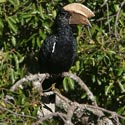 |
|
Bycanistes
bucinator (Trumpeter
hornbill) The Trumpeter hornbill occurs from Kenya and Angola to
southern Africa, where it is locally common in warm, coastal lowland forest,
especially near watercourses. It mainly eats small fruit, but it does on
occasion hawk insects, especially termite alates and may even eat bird eggs and
nestlings. It normally uses natural holes in trees as nesting sites, which the
female then seals with mud and faeces collected by the male, leaving a small
entrance hole. The female remains in the nest from when the eggs are laid,
through the incubation and nestling periods to when the chicks fledge, a period
of about 94 days! |
 |
|
Tockus
damarensis (Damara hornbill) The Damara
Hornbill occurs in Namibia and south-west Angola, preferring Acacia,
Mopane and broad-leaved savanna woodland. It mainly eats insects, foraging
on bare ground, occasionally catching insects in the air. The nest is
usually a natural tree cavity, its sealed from the inside by the female. It
lays 3-8 eggs, which are incubated by the female for around 24-27 days, with
the male doing the hunting for both of them. The chicks stay in the nest for
18-45 days, becoming fully independent a few days after
fledging. |
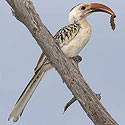 |
|
Tockus nasutus (African
grey hornbill, Grey hornbill) The African grey
hornbill occurs throughout the savannas of sub-Saharan Africa, from
Mauritania to southern Africa, where it is locally common in a wide range of
wooded savannas and woodland. It eats animals, such as birds eggs and
nestlings, insects, rodents and frogs, but it also occasionally eats small
fruit. It mainly nests in natural holes in tree trunks or branches, the
female sealing it with her own faeces. The female lays 3-5 eggs, which she
incubates for 24 days. The chicks stay in the nest for 43-49 days, joining
their parents in foraging a few weeks after fledging. |
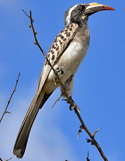 |
|
Tockus erythrorhynchus
(Red-billed hornbill) The Red-billed hornbill
occurs from south-eastern Angola east to Zambia, extending south to southern
Africa, where it is common in open, wooded savanna with sparse ground cover.
It feeds mainly on small insects, such as beetles, ants, termites and flies,
but it also eats larger arthropods, small vertebrates, small seeds and
fruits. It nests in natural cavities in trees 0.3-9 m above ground, which
the female seals with her own faeces. It lays 2-7 eggs, which are incubated
solely by the female, for 23-25 days. The chicks stay in the nest for 39-50
days, remaining near the nest for a few more days before joining their
parents in foraging. |
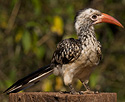 |
|
Tockus
leucomelas (Southern yellow-billed
hornbill) The Southern yellow-billed hornbill
is near-endemic to southern Africa, with small populations in southern
Angola, southern Zambia and southern Malawi, occurring in dry, open
Acacia and broad-leaved savannas. It eats a wide range of animals and
plant products, mainly foraging on the ground, looking for small animals,
fallen fruit and seeds. It nests in natural tree holes 0.75-12 m above
ground, the female closing the entrance with her own faeces. It lays 2-6, usually 3-4 eggs which are incubated by the female, for
roughly 24 days, being fed by the male through the entrance hole. The chicks
stay in the nest for 42-47 days, remaining near the nest for a few more days
before joining their parents in foraging trips. |
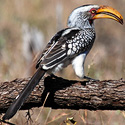 |
|
Tockus
alboterminatus (Crowned hornbill) The
Crowned hornbill occurs from the DRC and Ethiopia to southern Africa, where
it is locally common in a wide variety of forest and woodland habitats. It
eats a wide range of small animals, such as termite alates, chameleons and
millipedes, and plant products, such as fruit, seeds and nuts. It nests in
tree cavities 1.2-12 m above ground, used repeatedly over many breeding
seasons. It lays 2-5, usually 3-4 eggs, which are incubated solely by the
female, for 25-27 days, being fed by the male through a narrow slit. The
chicks stay in the nest for 46-55 days, and are able to feed for themselves
one month after fledging, but they remain in the area around the nest for
5-7 months more before becoming independent. |
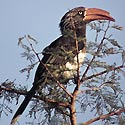 |
|
Tockus bradfieldi (Bradfield's
hornbill) The Bradfield's hornbill is near
endemic to southern Africa, mainly occurring in Namibia, Botswana and small
parts of Zimbabwe. It prefers broad-leaved woodland, feeding mainly on
invertebrates, but occasionally it eats small vertebrates and seeds. It
usually nests in natural tree cavities, although surprisingly, the first
recorded nest of this bird was in a rock crevice in Namibia, in 1937. It
usually lays 3 eggs, which are incubated solely by the female, for at least
28 days. The female emerges from the nest chamber when the chicks are about
32 days old, after which she helps the male in hunting for the brood. The
chicks usually stay in the nest for about 50 days, only becoming fully
independent when they are roughly 3 months old. |
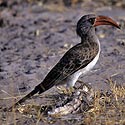 |
|
Tockus monteiri
(Monteiro's hornbill) The Monteiro's hornbill
is near endemic to southern Africa, occurring in Namibia and Angola. It
lives in the driest habitats of any hornbill in the world, preferring
desert-like habitats with lots of rocky hills. It feeds mostly on small
animals, especially invertebrates, but it may resort to eating seeds, fruit
and bulbs in the dry season. It usually nests in tree or rock cavities,
although it regularly uses nest boxes. It lays 2-8, average 4-6 eggs, which
are incubated solely by the female, for 24-27 days. The female leaves the nest when the oldest chick is roughly 22 days old,
after which the oldest chicks reseal the entrance. They eventually leave
when they are 44-46 days old, becoming fully independent a few days later. |
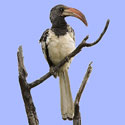 |
|
